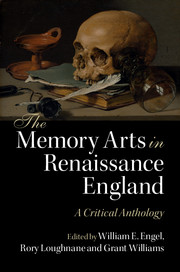Introduction
Published online by Cambridge University Press: 05 August 2016
Summary
I will be silent; yet that I may serve
But as a decade in the art of memory,
To put you still in mind of your own virtues
When your too serious thoughts make you too sad,
Accept me for your servant, honoured lady.
Ben Jonson, The Case is Altered (1609), D1rA character in Jonson's neglected early Plautine comedy (written c. 1597) invokes a formal technique of the art of memory – dividing memorised material into sets of ten (decades) – as a means to express his devotion to his beloved Phoenixella, who remains in mourning over the death of her mother. Dismissively, Phoenixella rejects her suitor's comments as common and ‘naught but ceremony’. The name of the admirer who knows about such mnemonic techniques, Francesco Colonna, can hardly be coincidental. The real-life Francesco Colonna, a Dominican priest, was reputed to be the author of Hypnerotomachia Poliphili, a heavily allegorical and mysterious erotic romance in prose. First printed by Manutius in Venice in 1499, the work included 172 woodcuts illustrating the hero Poliphilo's dream narrative quest to find his beloved Polia. Jonson owned a copy of the 1545 Aldine edition. Robert Dallington's abridged English translation of this rich work, The Strife of Love in a Dream, was first published in 1592. In The Art of Memory (1966), Frances A. Yates tentatively connects Colonna's work with, first, Dominican memory treatises influenced by Aquinas's advocacy of the art of memory (discussed below) and the diagrammatic structure of Dante's Commedia, as well as with, secondly, emergent humanist mysticism; she proposes that the romance's ‘Petrarchan triumphs and curious archaeology’, featuring a description of Hell ‘divided into places to suit the sins and their punishments, with explanatory descriptions’ might be understood as a type of ‘artificial memory gone out of control into wild imaginative indulgence’. Jonson (II.9), who does not refer to the art of memory directly elsewhere in his works (yet demonstrates an obvious awareness of its techniques), evidently associates Colonna with the general concept of memory training. Yet could a reader connect Yates's seductive reading of Hypnerotomachia with the allusion in Jonson's play? Does the intriguingly named character's passing reference to the art of memory constitute serious intellectual engagement by Jonson with the subject? Moreover, what does a reference such as this mean for the cultural awareness and relevance of the art of memory in Renaissance England?
- Type
- Chapter
- Information
- The Memory Arts in Renaissance EnglandA Critical Anthology, pp. 1 - 32Publisher: Cambridge University PressPrint publication year: 2016



